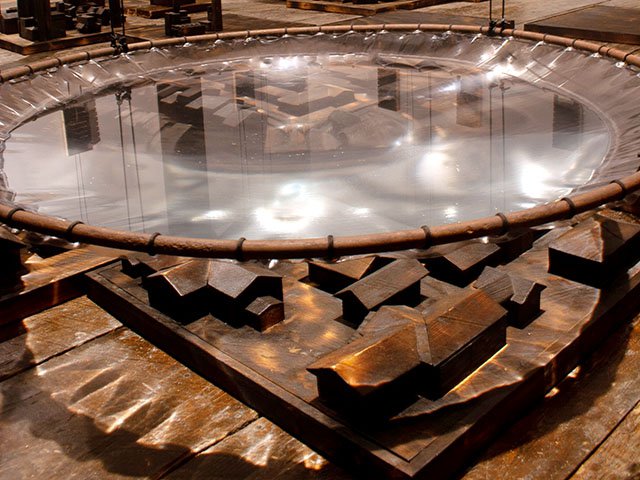January 16, 2020

Richard Jones’ new multi-media exhibit, the spaciousness of uncertainty, is at Abel Contemporary Gallery in Stoughton through Feb. 23.
To insiders, a “hot shop” is where a glassblower turns sand into glass, and glass into art, working over a furnace that heats to 2,400 degrees Fahrenheit. Studio Paran, one of Madison’s beloved glass studios, is definitely a hot shop.
Now Richard Jones — a graduate of the prestigious Rhode Island School of Design and the sole owner of the Winnebago Street studio since 2006 — wants to cool it down to focus on less carbon-intensive work.
On a planet that is facing daily crises related to climate and the environment, Jones just doesn’t see continuing this art form as a sustainable path. He’s thinking a lot about “climate disruption,” he says, and isn’t sure running a furnace every day to make luxury goods is the contribution he wants to make to the world. “This is really an all-hands-on-board, everybody- wake-up, we’ve-got-to-change situation,” says Jones, whose exquisite Japanese-inspired work and glassblowing demonstrations have drawn packed crowds of art lovers, especially on Gallery Nights. “We need a complete social overhaul.”
Jones’ singular focus has also taken its toll on his energy, and he wants to find a way to slow down. “I’m sort of tired of working so hard physically, I’ll be honest,” he says. “It’s kind of a drag to feel like you’ve got to produce. Every day I’ve got this furnace burning fuel, and I’d ask, ‘Why am I burning all this fuel?’
“Running a glass shop is 110 percent of your time…it sucks all your energy. It’s hard to do part time because of the equipment and the way you melt glass, if you want any kind of efficiency at all.”
Jones is also disturbed by Americans’ high levels of income disparity and over-consumption: “Even though I don’t make super high-end stuff, it’s still unnecessary. We are so lucky, and we don’t need to be buying all this shit. We just need to work at being grateful for what we have.”
By ending his glass work without a firm plan in place, Jones says he is likely to take a hit financially. But he also felt encouraged when his wife, Andrea Noeske, recently went back to school to get a nursing degree. “That was definitely inspiring, and at the same time, stabilizing,” says Jones. And, he adds, “I’m going to work at being poor. I think we need to get better at being poor. You don’t need a lot of money to be happy.”
He’s thinking a lot about what it means to be an artist and a part of a community, and wants to integrate teaching and activism into his life. “It’s going to be scary, and I’m going to have to be vulnerable, and I’m going to have to fake it until I make it. That’s the way I’ve tried to approach art in general. It’s a process. I’m not letting go of that.”
Jones plans to slowly liquidate his glass inventory at Studio Paran and sell off the equipment he uses to make it. Although he has primarily made his living selling glassworks, he has long been attracted to other art forms, including creating multimedia works that have a smaller “carbon footprint,” as the artist puts it. On Jan. 10, he opened an exhibit at Abel Contemporary Gallery in Stoughton, the spaciousness of uncertainty. The title reflects both his own future and the future of the planet. The installation features models of wooden boats floating in pools and burned buildings, and drawings of dried leaves.
Jones has been practicing drawing on a daily basis, and leaves are potent symbols. “Leaves are so ubiquitous and overlooked, but actually the foundation of civilization because they are building soil, and we are an extension of agricultural society. I’ve heard scientists say we have about 80 years left of viable agriculture. We’ve forgotten our connection to the Earth — this very simple thing, stop and look. Look at the world: It’s suffering and needs your attention. What’s important is right under our feet.”

Maureen Janson Heitz
Richard Jones has run Studio Paran since 2006.
Jones is not the only artist to note the distressing toll on the environment that running glass furnaces cause. A 2015 report from the Glass Art Society notes that “the environmental hazards of glass manufacturing, and exposure to harmful substances during the glass blowing, is a potential hurdle for the art form. The ramifications of the heavy carbon footprint created is just beginning to be discussed.”
Jones says he hasn’t looked deeply into alternative ways of running the studio, and when he began, he wasn’t thinking about the carbon footprint. “If I was starting out, I’d probably invest in super-efficient equipment, but now I need to pay off my debt,” he says. “If I could turn back the clock, maybe I’d have a cooperative studio, so there would be lots of people using it. But if I knew what I knew now, I’d probably be doing different work.”
When it comes down to it, Jones is satisfied with the glassworks he has created for 30 years, and is ready to explore new frontiers. “I think I’ve done what I want to do. People come into the shop and they might ask ‘What’s your favorite piece?’ It’s the piece I haven’t made yet. What’s really interesting is not what I’ve done; it’s what’s yet to be explored. That’s true of art and also true of life.”
